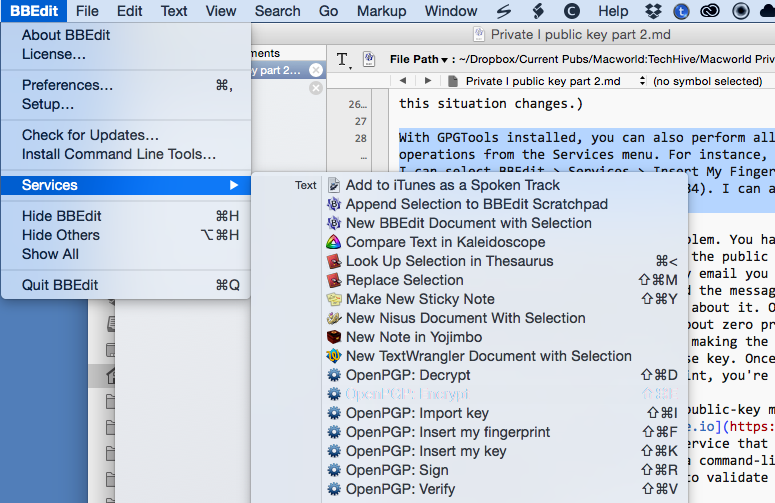Mail User Guide
Summary: This document descibes compatibility of PGP Desktop 8.x and Macintosh 10.4 (Tiger). Details: PROBLEM: PGP Desktop 8.x is NOT compatible with Macintosh 10.4, nor will it be updated to support this, or any future release of Macintosh OS X. PGP 8.x is supported by Macintosh 10.2.1 - 10.3.9. GnuPG 1.4 is the old, single binary version which still support the unsafe PGP-2 keys. This branch has no dependencies on the above listed libraries or the Pinentry. However, it lacks many modern features and will receive only important updates. OS X: Mac GPG: Installer from the gpgtools project. GnuPG allows to encrypt and sign your data and communication, features a versatile key.
Email messages that are digitally signed or encrypted can offer enhanced security when sending or receiving email.
Send digitally signed and encrypted emails
A digitally signed message lets your recipients verify your identity as the sender; an encrypted message offers an even higher level of security. To send signed messages, you must have a personal certificate in your keychain. To send encrypted messages, the recipient’s certificate must be in your keychain.
In the Mail app on your Mac, choose File > New Message.
Move the pointer over the From field, click the pop-up menu that appears, then choose the account for which you have a personal certificate in your keychain.
A Signed icon (containing a checkmark) in the message header indicates the message will be signed when you send it.
Address the message to recipients.
An Encrypt (closed lock) icon appears next to the Signed icon if your keychain contains a personal certificate for every recipient; the icon indicates the message will be encrypted when you send it.
If you don’t have a certificate for every recipient, you must send your message unencrypted. Click the Encrypt icon to replace the closed lock icon with an open lock icon.
Some mailing lists reject digitally signed messages because the signature is treated as an attachment. To send the message unsigned, click the Signed icon in your message; an x replaces the checkmark.
Note: If for some reason your certificate isn’t associated with your email address, or if you want to use your certificate with a different email address, Control-click the certificate in Keychain Access, choose New Identity Preference, and provide the requested information.
Receive digitally signed and encrypted emails
In the Mail app on your Mac, a Security field in the header area indicates whether a message is signed or encrypted.
Pgp For Mac Os X 10.7
A signed icon (a checkmark) appears in the header area of a signed message. To view the certificate details, click the icon.
If the message was altered after it was signed, Mail displays a warning that it can’t verify the message signature.
A lock icon appears in the header area of an encrypted message. If you have your private key in your keychain, the message is decrypted for viewing. Otherwise, Mail indicates it can’t decrypt the message. See If Mail can’t decrypt emails.


If you want to include encrypted messages when you search for messages in Mail, set the option in the General pane of Mail preferences. The option enables Mail to search individual words, even though the message is stored encrypted.
Pre-installation notes

Pgp For Mac Os Xerox
- Previously installed PGP software: If you areusing a version of PGP that was not distributed fromIUware, some features you currently use may be disabledafter installing the IU licensed PGP software. Consult yourLSP before installing. Details of upgrading from olderversions are documented in the PGPDesktop User Guide, distributed in the IUware disk image.
- Compatibility: PGP 10.2.1 is compatible with MacOS X 10.6 to 10.7.4. It is not compatible with newer or older versionsof Mac OS such as 10.5.8, 10.7.5 or 10.8. When using PGP do not updateOS X to a new version without first updating PGP. IUware will havenew versions of PGP soon after they are made available by Symantec.
- Boot Camp: If you use Boot Camp, read UsingBoot Camp with PGP WDE before installing. You must install boththe Mac and Windows versions of PGP before encrypting your drive.
- Upgrading from 10.5 to 10.6: If you are upgradingfrom Mac OS X 10.5.8 to 10.6.x, decrypt your drive and uninstall anyprevious versions of PGP Desktop. Be sure to back up your keys andkeyrings before uninstalling.
- System Requirements:
- Mac OS X 10.6.8 to 10.7.4. UITS recommends upgradingto a minimum of Mac OS X 10.6.8 before installation. PGP 10.2.1 is notcompatible with versions of Mac OS X older than 10.6.
- 512 MB of RAM
- 64 MB hard disk space
Installing PGP Desktop
Pgp For Mac Os X High Sierra
- Mount the PGP Desktop disk image.
- Double-click PGP.pkg and follow the instructions.
- When the installation is complete, restart your computer.
- After restarting, authorize the software using yourIU username and passphrase.
To encrypt your Mac drive, see ARCHIVED: Encrypt your Mac computer with PGP.
Pgp For Mac Os X
For more about PGP Whole Disk Encryption, see the SymantecKnowledge Base.
